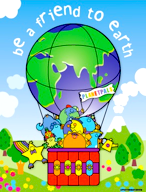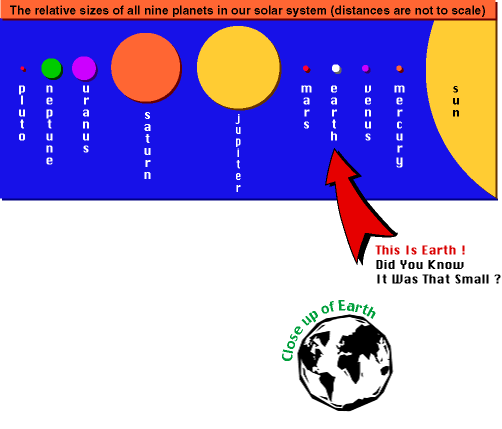


|


Compare the size of the Earth
to the other planets!

* In 2006 Pluto was no longer considerred a planet. It was discovered to be a DWARF. Since there are more than 40 of these dwarfs, including the large asteroid Ceres and 2003 UB313, nicknamed Xena...it has been downgraded.
* Earth is the third planet from the sun. Did you realize that it was one of the smallest planets in OUR solar system? If you want to know more fast facts about EARTH seeEarth Fast Facts Page |
|---|
Planet Terri |
A quick dose of solar history!
The solar system and it's relationship to Earth
There are nine planets that travel around the sun. In order of distance they are Pluto, Neptune, Uranus, Saturn, Jupiter, Mars, Earth, Venus, and Mercury. Together with the sun they make up our solar system.
The planets are in motion and travel around the sun in oval shaped paths called orbits. Each planet travels it’s own orbit. Each planet also rotates on an axis, which means it spins around its centerline.
Did you know that the sun is not a planet but a star? Just like the stars you see at night. Though it is more than 100 timeslarger than earth it is just average size for a star.
 |
|---|
Sunnyray |
Our planet earth is one of the smaller planets, but it is pretty large at 7,926 miles in diameter. It takes almost exactly 24 hours to rotate and that’s how we get our day.
The MOON
The moon is another body in our solar system. It is covered with deep pockets called craters. One side of the moon is always facing earth. However, the earth turns on it's own orbit. When earth facing the moon, and away from the su.n we have night.
The moon has no light of it’s own. It only reflects the light from the sun.
 |
|---|
Moonbeam |
The light of the moon is called a moons phase. The moon has many phases such as the full moon and new moon. It takes 27 days for it to travel through all of them. That is how we calculate our months!
When we see the moon at night, people in countries opposite each other on the globe, such as the United States and Japan, have daytime. When they have night, we have day. Around we go.
No matter where we all live on earth we share the same sun and moon.
Did you know that ancient cutures have names for the full moon?
For instance the April Full Moon has Names like-Planter's Moon - Peony Moon - Flower Moon-Wildcat Moon - Growing Moon - Seed Moon-Awakening Moon - Moon When Geese Return in Scattered Formation.
These names have deep rooted meaning depending on location and natural habitat.
Comets, Satelites, Asteroids
Did you know there are thousands of objects in the space that travel around the sun and moon? Many of them are asteroids, comets and satellites.
Comets are chunks of dust, rock and ice that move so fast that they form a tail of gas. That gas gets stronger the closer they get to the sun.
There are famous comets that have been discovered. One of them was found by an astronomer named Haley and it is called Haley’s comet. Comets come around many times. Haley’s comet will reappear in 2062.
Asteroids on the other hand, are considered minor planets. Often made up of small chunks of rock or metal. The largest one is Ceres at 600 miles.
Satellites move in orbits around planets, just as the planets orbit around the sun. Don’t make the mistake of thinking satellites are just manmade. Moons are natural satellites!
EXERCISE Your KNOWLEDGE:
Why not have a PLAY about the Planets!
Why not have a play about the solar system and the size of the planets at home or school!
It's easy, just assign a planet to each kid...extras can be moon, stars, comets, satelites or asteroids. Have them learn facts about their solar body, Each person then take their place and rotate around each other, reciting their knowledge. Perhaps they could even make up a story !
NEXT:
| Learn about Earth | Look at the size of the earth! |
| Read Earth Fast facts | See The Food Chain |
| SEE the wonders of the world | Learn about ecology |
Webmaster: Planetpals Copyright 1991 Judith Gorgone-all rights reserved


